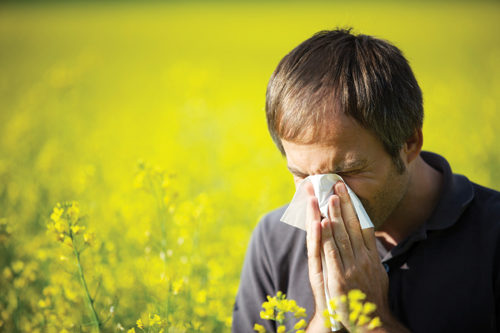While some greet the arrival of spring with joy, others regard it with dread. These people can be seen stocking up on tissues, and they often look afraid to go outside. Those with seasonal allergies and asthma are in constant search of relief. Some allergies, meanwhile, wreak havoc year-round, as symptoms are always close at hand. Your allergy-stricken customers will certainly benefit from understanding their conditions better. They’ll also be in line to thank you if you can offer them natural herbs and compounds to help them stay symptom free.
Meet Your Allergies
Allergy sufferers may often ask themselves, “Why me?” Well, while there’s nothing they did to deserve their symptoms, there is a rhyme and reason as to who gets them. First, the skinny on seasonal sneezes starts with the way these symptoms present themselves.
To help distinguish allergy symptoms from those of the common cold, consider the following tell-tale signs (1). Symptoms including sneezing, runny nose and nasal congestion that occur all at once, rather than one following up the other, are often an indication that one is dealing with an allergy attack. The occurrence of actual sneezes can also be a sign of allergies rather than cold, especially if those sneezes come rapid-fire, as in two or three at a time. Finally, a fever will most often be a tip-off that an illness is to blame for symptoms, rather than an allergen in the environment.
Nasal allergies that clog the upper respiratory system can make life unbearable, and sufferers typically have their parents to thank. That’s because when allergies develop, they do so from a foundation of inheritance (2). The degree and length of exposure to antigens like pollen influence if and when this tendency will show itself.
Though individuals with allergies can’t very well shut their nasal passages to keep the allergens at bay, they can at least know what and what not to be wary of. Tell them to remain aware of their local pollen conditions throughout the spring and summer months, which are made widely available in most weather reports. For the most part, only wind-pollinated plants including certain trees and grasses cause allergic reactions, and not wildflowers or garden flowers pollinated by insects (2). So, those with allergies should feel free to stop and smell the roses on their way to their health food store for some natural allergy relief. Which brings us to the more pressing question plaguing your customers: How do I get rid of this already?
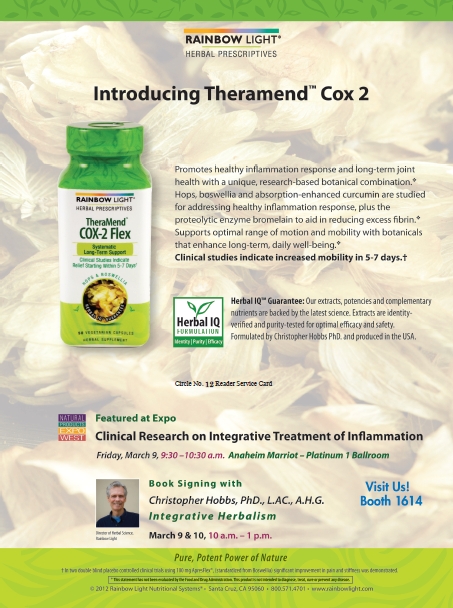 Hay Fever Relievers
Hay Fever Relievers
Herbs are standouts for allergy care. Here are five herbs your sneezing and watery-eyed shoppers should know about.
Butterbur. Butterbur (Petasites hybridus) has historically been used to treat a host of ailments from headaches to asthma, but today, one can draw on its research support for allergy care. In one study, researchers from the Petasites Study Group in Germany and the Allergy Clinic in Switzerland gave a high dose of butterbur extract to 60 patients, a low dose of the herb to 65 patients and a placebo to 61 patients. The team analyzed the effect on various seasonal allergy symptoms like runny nose, sneezing and congestion. In the end, those taking the higher butterbur dose saw the most improvements, and no negative side effects were noted (3).
Stinging nettle. Some supplement formulators believe the way to go for allergy relief is with nettle. In 2009, research published in Phytotherapy Research offered some good back-up for why. The scientists looked at one nettle extract (Urtica dioica) and determined it stopped several events that cause inflammation in the body. For instance, nettle extract was found to block histamine from binding to histamine 1 (H1) receptors, in essence inhibiting an allergic reaction like hay fever. It also stopped other inflammatory responses by inhibiting COX-1, COX-2 and other proinflammatory enzymes (4).
Quercetin. Flavonoids, water-soluble plant-based pigments, are antioxidants that are said to possess several important anti-allergenic, anti-histamine and anti-inflammatory properties (5). One such flavonoid found in several allergy care supplements is quercetin. Experts feel this component inhibits leukotrienes and histamine, two important contributors to the allergy cascade (5).
Bromelain. While shoppers may think of bromelain for digestion support, they should also be aware that it may support allergy care. Bromelain is said to help break down mucus and lessen inflammation by stopping the synthesis of proinflammatory agents (like prostaglandins and arachidonic acid) (5).
Traditional Chinese medicine. One shouldn’t necessarily look at allergy relief as a series of standalone ingredients. Many formulas are based on the principles of traditional Chinese medicine, which involves combinations of ingredients as a holistic system that helps restore balance and harmony in the body (5). To exemplify this point, one branded natural supplement combines 23 herbs for allergy relief, including playcodon root, peppermint, ganoderma, glycyrrhiza and clerodendron. In a pilot study, the combination of these herbs helped improve chronic asthma symptoms (6).
Omegas and (m)E
The allergy care market has several non-herbal contributors, two of which are vitamin E and the omega-3 EPA. When the diets of about 1,700 individuals were analyzed, researchers discovered that those who consumed the most EPA and vitamin E were the least likely to develop seasonal allergies. The group speculates that the anti-inflammatory properties of EPA may thwart allergies. With regard to vitamin E, “its negative effect on the production of [prostaglandin E2] may be contributing factors to the inverse association of increasing vitamin E intake and hay fever seen in this study” (7).
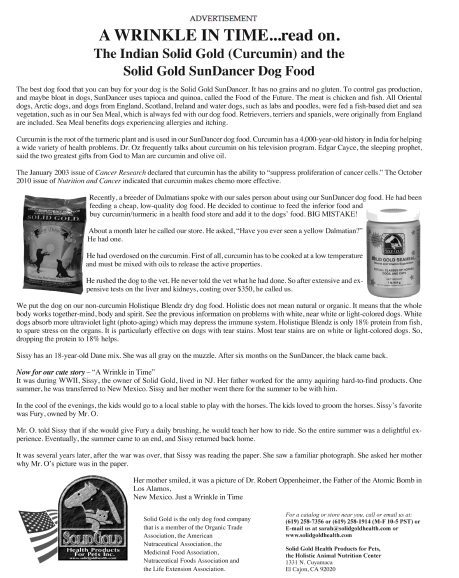 Nasal Washes
Nasal Washes
Natural nasal sprays and saline solutions are important tools against seasonal allergies. These over-the-counter (OTC) remedies help clear nasal passages of pollen, excess mucus and debris. They can also be used to restore moisture to dry noses and keep cilia (small nose hairs that help trap bacteria) healthy (8). Saline sprays can aid in loosening mucus retained in the sinuses, decreasing crusting and inflammation inside the sinuses. With regular use, saline sprays may thin mucus, decrease postnasal drip and cleanse bacteria from nostrils (8).
There are a few different kinds of saline solutions. Most OTC saline solutions and sprays are isotonic (the same saline concentration as in the body), but there are also hypertonic saline sprays that have more salt than found in normal bodily tissue (8).
Customers may want to know if this solution can be made at home. The answer is yes, but there are risks. The solution is comprised of mixing about two or three teaspoons of kosher salt (to avoid additives) and one teaspoon of baking soda into one pint of room temperature water; if the sensation is uncomfortable or stinging, advise using less salt in the mixture (8). With the aid of a squeeze bottle or bulb, or with a specially designed nasal irrigation device like a neti pot, run the water through one nostril and out the other, tilting the head back to coax the solution into the nasal cavities and throat. Users should repeat in the other nostril and blow their noses afterward to flush out any remaining fluid while standing over a sink to avoid mess (8).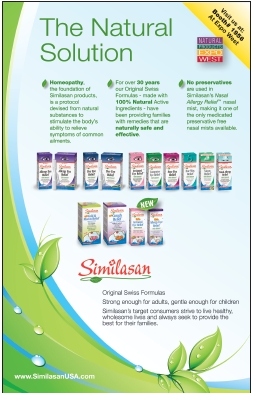
The risks develop when cleaning and sterilization are not handled properly. Whether your customers are using a store-bought mixture or making their own, remind them of the importance of cleaning their nasal allergy tools to avoid bacteria and infection. Water used to make an at-home solution should be distilled, sterile or previously boiled to avoid unwanted bacteria (8). Some customers may have heard some bad press recently about the use of nasal irrigation devices, but these stories can be chalked up to human error; washing out neti pots or other nasal irrigation devices is of the utmost importance. One neti pot supplier believes, “The Neti Pot should be cleaned after each and every use with an antibacterial dishwashing liquid and hot water. For optimum cleaning, you should use a small nylon bristled brush that fits into the pot and allows you to access all areas. You will want to concentrate on both inside and outside the nostril pot and thoroughly scrub the spout” (9). The company advises against using a sponge to clean and sharing your devices, as both will only help spread harmful bacteria. WF
References
1. “A Cold or Seasonal Allergies?” WebMD the Magazine, Oct. 31, 2005, www.medicinenet.com/script/main/art.asp?articlekey=55042, accessed Feb. 13, 2012.
2. “Allergy Overview,” Asthma and Allergy Foundation of America, www.aafa.org/display.cfm?id=9&cont=79, accessed Feb. 13, 2012.
3. M. Williams, “Butterbur to Treat Hay Fever,” Healthnotes Newswire, www.bastyrcenter.org/content/view/330/, accessed Feb. 13, 2012.
4. B. Roschek, “Nettle Extract (Urtica dioica) Affects Key Receptors and Enzymes Associated with Allergic Rhinitis,” Phytother. Res. 23 (7), 920–926 (2009).
5. J. Berkowiz, User’s Guide to Natural Allergy Relief (Basic Health Publications, North Bergen, NJ, 2003).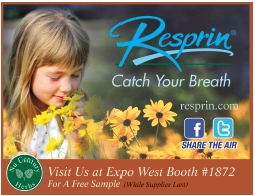
6. Nu Century Herbs, http://resprin.com/shop/ask_the_experts.php, accessed Feb. 13, 2012.
7. G. Nagel et al., “The Influence of the Dietary Intake of Fatty Acids and Antioxidants on Hay Fever in Adults,” Allergy 58 (12), 1277–1284 (2003).
8. “Natural Allergy Relief: Saline Nasal Sprays,” www.webmd.com/allergies/saline-spray, accessed Feb. 13 2012.
9. “How to Clean a Neti Pot,” www.neti-pot.biz/how-to-clean-a-neti-pot.php, accessed Feb. 13 2012.
Published in WholeFoods Magazine, March 2012

